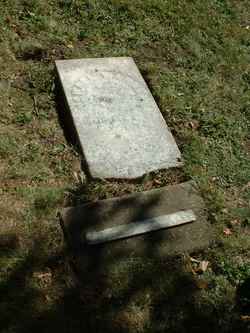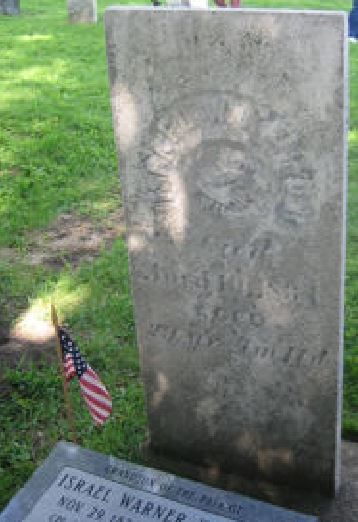Revolutionary War veteran. Joined the army in 1777 at the age of 9 and served as a messenger and a scout until 1783. Son of Col. Seth Warner of the Battle of Bennington.
OPINION
Cemeteries hold Aurora's Revolutionary War connection
By Denise Crosby
Chicago Tribune
•
Last Updated: Jul 03, 2015 at 2:00 am
Expand
Revolutionary War soldier Israel Warner's grave marker at Big Woods Cemetery on Eola Road in Aurora.
Revolutionary War soldier Israel Warner's grave marker at Big Woods Cemetery on Eola Road in Aurora. (Fox Valley Chapter DAR, Handout)
If you've been paying even a little bit of attention to the stories we've run in the past, you know how much Aurora loves its veterans.
But how much do residents know about the oldest of our soldiers, particularly those who fought during the war that led to the Declaration of Independence we're celebrating this weekend?
Turns out, there are three Revolutionary War soldiers buried here, although none were born and raised in Aurora, for obvious reasons.
When Washington's army was fighting the British way back in the day, Illinois was not even on the map. The occupants of our future community were Native Americans, predominantly Potawatomi. And it stayed that way, noted Aurora Historical Society Executive Director John Jaros, until they were forced out by the white settlers.
In 1763, the future Illinois, part of French Canada, was ceded to the British as part of the treaty ending the French and Indian War. And in 1783 it became part of the lands ceded by the British to the new United States in the treaty ending the American Revolution.
Illinois did not become a state until 1818, at which time all the northern portion was still Indian territory, the historian said. And it wasn't until 1833 when the Treaty of Chicago was signed ending the Blackhawk War that the state really opened up for settlement.
Settlers did indeed pour in from the East, said Jaros, with Aurora's first official permanent settler being Joseph McCarty in the spring of 1834.
"It seemed like Aurora's Revolutionary soldiers, now much older and following younger family members, arrived within the couple of decades after this first settlement, once the area was settled and thriving," he added.
Among the trio who died and are buried here: Frederick Vaughan. According to the Sons of the American Revolution Fox Valley Chapter website, Vaughan, born in 1767, enlisted in the Connecticut Militia at the ripe old age of 13. He served for nine months in a company employed as guards and scouts along the Connecticut coast.
Vaughan (also spelled Vaughn) re-enlisted for three additional months in 1782 in a company commanded by his father, John Vaughan, where they mostly performed garrison duty in New York under Col. Samuel Canfield.
After the war, Vaughan lived in New York for most of his life. He moved to Kane County in May of 1845 at age 78, only to die three months later.
Vaughan was buried in the now-defunct Root Street Cemetery. But in June of 1914, through the efforts of the Aurora chapter of Daughters of the American Revolution, his remains were moved to Spring Lake Cemetery in Aurora, where the chapter later placed a granite and bronze marker at his grave.
The second soldier, Israel Warner, is a more interesting character, if for no other reason than because of the famous footsteps he followed.
Warner was born in 1768, the oldest son of the soldier who would become one of the most revered patriots in Vermont's history.
His dad was Seth Warner, co-founder of the legendary Green Mountain Boys, and who was elected its commander over the eventually more well-known Ethan Allen, according to the Fox Valley chapter of the Sons of the American Revolution website.
Israel was the son of Seth Warner, co-founder of the legendary Green Mountain Boys, and who was elected its commander. Little Israel, obviously a chip off the old block, joined the Continental Line of the Army in 1777 at the tender age of 9 and served until age 15. According to the Fox Valley Chapter of the Sons of the American Revolution website, the younger Warner acted as a messenger and scout. In the Battle of Bennington, "the 9-year-old carried a critical message from his dad to Gen. Stafford on a galloping horse to bring re-enforcements."
The elder Warner died at age 41 of his many battle wounds, when Israel was only 16.
While historians can't confirm its truth, the story goes that George Washington himself rode to the Warner widow's farm in 1789 and counted out the silver coins she would need to save the property after falling behind on the mortgage while her husband was off fighting for a rising young nation.
After his father's death, the website notes, Israel supported his mother and younger siblings as a land surveyor in Whitehall, New York. He married in 1801 at age 33 and had a son and two daughters. Israel Warner arrived in Illinois in 1853 with his two daughters and their families and lived with one daughter until his death in 1862 at age 93.
He is the first of the family to be buried in the Big Woods Cemetery on Eola Road just south of Butterfield Road. Source: https://www.chicagotribune.com/suburbs/aurora-beacon-news/opinion/ct-abn-crosby-graves-st-0703-20150703-story.html
Husband of Esther Bartholomew Warner (m.1801).
Revolutionary War veteran. Joined the army in 1777 at the age of 9 and served as a messenger and a scout until 1783. Son of Col. Seth Warner of the Battle of Bennington.
OPINION
Cemeteries hold Aurora's Revolutionary War connection
By Denise Crosby
Chicago Tribune
•
Last Updated: Jul 03, 2015 at 2:00 am
Expand
Revolutionary War soldier Israel Warner's grave marker at Big Woods Cemetery on Eola Road in Aurora.
Revolutionary War soldier Israel Warner's grave marker at Big Woods Cemetery on Eola Road in Aurora. (Fox Valley Chapter DAR, Handout)
If you've been paying even a little bit of attention to the stories we've run in the past, you know how much Aurora loves its veterans.
But how much do residents know about the oldest of our soldiers, particularly those who fought during the war that led to the Declaration of Independence we're celebrating this weekend?
Turns out, there are three Revolutionary War soldiers buried here, although none were born and raised in Aurora, for obvious reasons.
When Washington's army was fighting the British way back in the day, Illinois was not even on the map. The occupants of our future community were Native Americans, predominantly Potawatomi. And it stayed that way, noted Aurora Historical Society Executive Director John Jaros, until they were forced out by the white settlers.
In 1763, the future Illinois, part of French Canada, was ceded to the British as part of the treaty ending the French and Indian War. And in 1783 it became part of the lands ceded by the British to the new United States in the treaty ending the American Revolution.
Illinois did not become a state until 1818, at which time all the northern portion was still Indian territory, the historian said. And it wasn't until 1833 when the Treaty of Chicago was signed ending the Blackhawk War that the state really opened up for settlement.
Settlers did indeed pour in from the East, said Jaros, with Aurora's first official permanent settler being Joseph McCarty in the spring of 1834.
"It seemed like Aurora's Revolutionary soldiers, now much older and following younger family members, arrived within the couple of decades after this first settlement, once the area was settled and thriving," he added.
Among the trio who died and are buried here: Frederick Vaughan. According to the Sons of the American Revolution Fox Valley Chapter website, Vaughan, born in 1767, enlisted in the Connecticut Militia at the ripe old age of 13. He served for nine months in a company employed as guards and scouts along the Connecticut coast.
Vaughan (also spelled Vaughn) re-enlisted for three additional months in 1782 in a company commanded by his father, John Vaughan, where they mostly performed garrison duty in New York under Col. Samuel Canfield.
After the war, Vaughan lived in New York for most of his life. He moved to Kane County in May of 1845 at age 78, only to die three months later.
Vaughan was buried in the now-defunct Root Street Cemetery. But in June of 1914, through the efforts of the Aurora chapter of Daughters of the American Revolution, his remains were moved to Spring Lake Cemetery in Aurora, where the chapter later placed a granite and bronze marker at his grave.
The second soldier, Israel Warner, is a more interesting character, if for no other reason than because of the famous footsteps he followed.
Warner was born in 1768, the oldest son of the soldier who would become one of the most revered patriots in Vermont's history.
His dad was Seth Warner, co-founder of the legendary Green Mountain Boys, and who was elected its commander over the eventually more well-known Ethan Allen, according to the Fox Valley chapter of the Sons of the American Revolution website.
Israel was the son of Seth Warner, co-founder of the legendary Green Mountain Boys, and who was elected its commander. Little Israel, obviously a chip off the old block, joined the Continental Line of the Army in 1777 at the tender age of 9 and served until age 15. According to the Fox Valley Chapter of the Sons of the American Revolution website, the younger Warner acted as a messenger and scout. In the Battle of Bennington, "the 9-year-old carried a critical message from his dad to Gen. Stafford on a galloping horse to bring re-enforcements."
The elder Warner died at age 41 of his many battle wounds, when Israel was only 16.
While historians can't confirm its truth, the story goes that George Washington himself rode to the Warner widow's farm in 1789 and counted out the silver coins she would need to save the property after falling behind on the mortgage while her husband was off fighting for a rising young nation.
After his father's death, the website notes, Israel supported his mother and younger siblings as a land surveyor in Whitehall, New York. He married in 1801 at age 33 and had a son and two daughters. Israel Warner arrived in Illinois in 1853 with his two daughters and their families and lived with one daughter until his death in 1862 at age 93.
He is the first of the family to be buried in the Big Woods Cemetery on Eola Road just south of Butterfield Road. Source: https://www.chicagotribune.com/suburbs/aurora-beacon-news/opinion/ct-abn-crosby-graves-st-0703-20150703-story.html
Husband of Esther Bartholomew Warner (m.1801).
Family Members
Advertisement
Records on Ancestry
Advertisement














